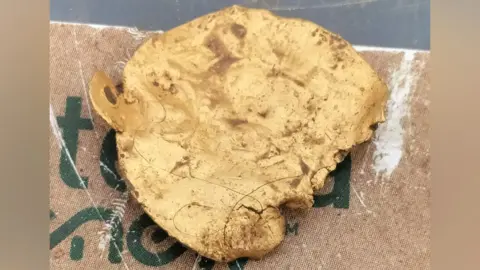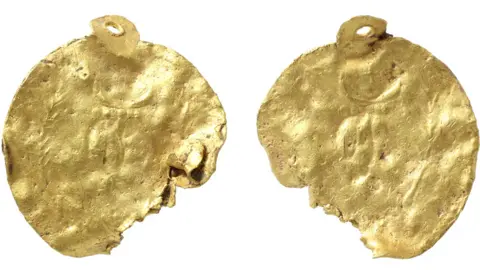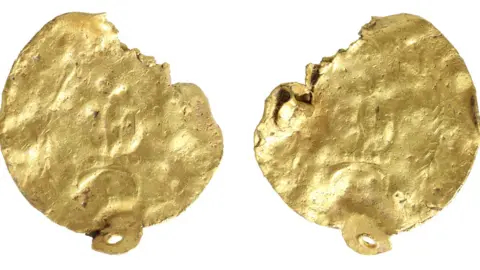Burston detectorist finds Roman gold earring in field
 Nick Batemen
Nick BatemenA metal detectorist said he sank to his knees in disbelief when he realised a metal milk bottle top he had unearthed was in fact a gold earring.
Nick Bateman, 53, from Burston, Norfolk, made the find in a field he had nicknamed "disappointment" after regular searches revealed "junk".
The earring was initially believed to be medieval but closer examination by an expert revealed it was Roman.
It has been declared treasure and will be lent to a Diss Museum exhibition.
 The Portable Antiquities Scheme
The Portable Antiquities SchemeMr Bateman made the discovery in a south Norfolk field on Christmas Eve 2021.
"I'd done all the Christmas stuff so I thought I'd go out for a sneaky hour or two," he said.
"It wasn't the best signal in the world but I dug down three or four inches (seven to 10 cm) and saw what I thought was a gold metal bottle top, but when I cleared off the mud I realised I'd found gold and sunk to my knees in disbelief."
 Nick Batemen
Nick BatemenThe builder took up the hobby seriously during lockdown in 2020.
Guided by experienced detectorist Joe Edwards-Gill, he soon exceeded his mentor's experience.
He said: "Joe says, 'Nick's been detecting for five minutes and he's already got five pieces going through the treasure process and I've been detecting for 10 and only found one', so I do seem to be the luckiest person."

Metal detecting and the law
- No search can begin until permission has been given by the landowner
- All finds belong to the landowner
- Any find in England, Wales and Northern Ireland that is more than 300 years old, made of gold or silver, or found with gold or silver artefacts, could be treasure under the 1996 Treasure Act
- These must be reported to the appropriate county finds liaison officer
Source: Portable Antiquities Scheme

 Nick Bateman
Nick BatemanThe "fairly battered" 20.5mm by 22.1mm (0.8in) earring was reported to the coroner and examined by numismatist Adrian Marsden from the Norfolk Historic Environment Service.
"A colleague thought it was medieval as he could see a tiny cross under one of the loops," he said.
"But when I looked closely I could see a laurel wreath and an eagle and that's exactly the sort of thing you get on Roman objects.
"Other artefacts like this had gone down as medieval, so it does show you need to keep your wits about you when you examine these things."
 The Portable Antiquities Scheme
The Portable Antiquities SchemeThe pattern was punched out on two discs of gold, which were soldered together.
It would have had two loops, one to hang from a ear hook, while a now missing object would have been suspended from the second loop.
Mr Bateman said the "disappointing" field has since yielded various artefacts currently being assessed through the treasure process.
He said: "Every time I look at it, I wonder what that Roman woman's life was like, what she looked like and how she came to lose the earring in a Norfolk field."

Find BBC News: East of England on Facebook, Instagram and Twitter. If you have a story suggestion email eastofenglandnews@bbc.co.uk